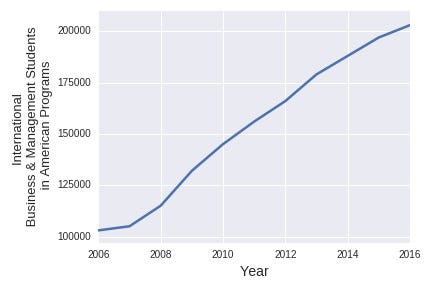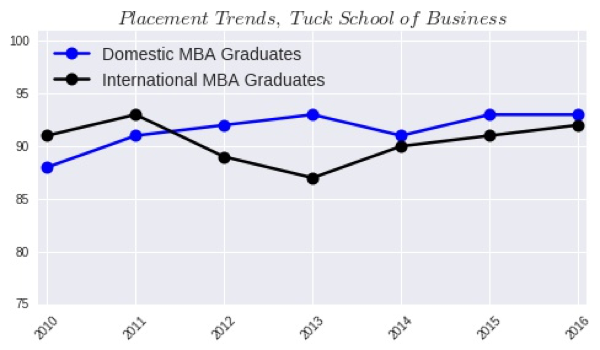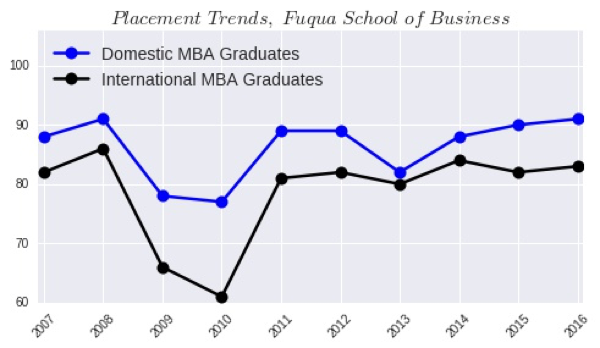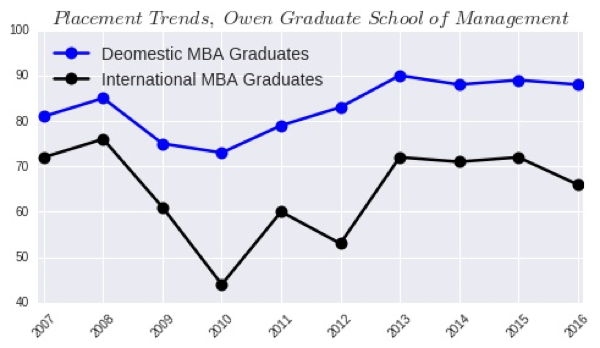I’m a firm believer that information is the key to financial freedom. On the Stilt Blog, I write about the complex topics — like finance, immigration, and technology — to help immigrants make the most of their lives in the U.S. Our content and brand have been featured in Forbes, TechCrunch, VentureBeat, and more.
See all posts Frank GogolIs an MBA in the U.S. Worth It for International Students?
America is the preeminent destination for international MBA aspirants, with over 66% of international GMAT test takers aiming to gain admission to American institutions. Almost 60% of the applicant pool at full-time MBA programs in the US is constituted of international applicants.
A vast majority of the international applicants to American MBA programs hail from China, India, South Korea, and similarly distant countries. Due to the geographical remoteness, these applicants have to often rely on limited, non-specific data and anecdotal evidence to guide their decisions. For instance, the prospect of starting salaries of over a hundred thousand per annum reported by many programs may seem highly enticing to international MBA aspirants. However, these figures are neither specific to international students, nor representative of the ground realities they shall face after their graduation.
In this article, using extensive datasets specifically tailored for International MBA graduates from American institutions, we address, analyze and answer some important questions to enable International MBA aspirants to make a sufficiently informed decision about their futures.
Competing for Limited Resources
“Most international MBA feel that they are going to ‘beat the odds.’ Some might have heard that there may be a long road ahead of them when searching, but most underestimate the sheer difficulty in securing a quality job in the USA.”
Marcel Barros, The International Advantage
Over the last 10 years, the number of international students enrolled in Business & Management programs in American universities has more than doubled. GMAC surveys indicate that almost 87% of these students don’t just want an education from America, but a career in America.
However, the total H-1B visa allocation has remained stagnant. In fact, over the last decade, the number H-1B visas granted to Business & Management based occupations has almost halved. And it goes without saying, a significant proportion of these visas are issued to individuals located abroad and those from other disciplines. For instance, in 2013, 11 of the top 25 recipient companies were outsourcing firms.

Figure 1A. Number of International citizens enrolled in Business and Management programs in American universities

Figure 1B. H1-B visas issued for Business and Management related occupations.
Disposition of Corporate Recruiters
For international MBA students, the hurdles for their budding careers commence even before the onset of the college placements, wherein over half of the corporate recruiters for American MBA programs clearly state that they will not hire international MBA graduates. While there are many purported reasons to hire international workers, for instance, their global perspectives, polyglotism, and diversity, only about a quarter of the recruiters have definite plans to hire international MBA graduates.

Figure 2. Stances of Corporate recruiters to American MBA programs regarding the hiring of international graduates.
The primary reasons underlying this bias are the lengthy and convoluted legal process that the companies have to go through to enable work visas for such hires. Additionally, recruiters point to the ensuing uncertainty in the status of international workers, the linguistic and cultural barriers, and their inability to integrate in the American work environment.

Figure 3. Key reasons indicated by corporate recruiters against hiring international MBA graduates.
“International students face an uphill battle when seeking jobs in the USA, from a lack of visas to employers unwilling to take a risk.”
J.P. Matychak, School of Management, Boston University
Placement and Salary Trends for International MBA Graduates

Figure 4. Comparison of Domestic versus International graduates with job offers at graduation.
This predisposition is reflected in the college placement of international MBA graduates, as opposed to domestic graduates.
Facts for International Graduates from American MBA Programs
- Less than half of international graduates from American MBA programs have even a single job offer at graduation.
- In sharp contrast, almost 3/4 of domestic graduates have job offers by the time they graduate.
This is a critical statistic for international students who face a 90-day deadline after graduation to commence their employment.

Figure 5. Distribution of Mean starting salaries for international MBA graduates versus the rank of the MBA program. The blue line represents the best fit linear regression.
While there are many factors that determine the career prospects of international MBA graduates, the simplest and most holistic predictor for their success is, not surprisingly, the rank of the MBA program they join. As can be seen in the figure, the mean starting salary for international MBA graduates shows an explicit and robust dependence on the rank of the program (such as the case that is seen in software engineer salaries, for example).
The Biggest Predictor of Salary and Job Offers for International Graduates
- The highest ranked programs consistently have mean starting salaries for international MBA graduates of over $120,000 per annum.
- In stark contrast, the programs ranked beyond 80 usually have mean starting salaries for international MBA graduates below $60,000.
The relationship between mean starting salaries for international MBA graduates and the program rank is seemingly linear. Based on a linear model, a drop in the rank by 10 positions is correlated to a reduction in the expected starting salary by almost $10,000.

Figure 6. Percentage of international MBA graduates with job offers at graduation versus rank of the MBA program. The blue line represents the best fit linear regression.
A similar trend is observed between the rank of a program and the placement offered to international MBA graduates. At the highest ranked schools, almost all international MBA students have at multiple job offers by graduation.
Contrastingly, at MBA programs beyond the 70th place, less than half of the international MBA graduates looking for a job have even a single offer by their graduation date.
Based on a linear model, a drop in the rank by 10 positions is correlated with a reduction of over 5% in the probability of the international MBA student having a job offer by graduation.
Variations over MBA program for International MBA Graduate Placement

Figure 7A. Comparison of Domestic versus International MBA graduates with job offers at graduation at Tuck School of Business, Dartmouth College.

Figure 7B. Comparison of Domestic versus International MBA graduates with job offers at graduation at Booth School of Business, University of Chicago

Figure 8A. Comparison of Domestic versus International MBA graduates with job offers at graduation, Darden School of Business, University of Virginia.

Figure 8B. Comparison of Domestic versus International MBA graduates with job offers at graduation, Fuqua School of Business, Duke University.

Figure 9A. Comparison of Domestic versus International MBA graduates with job offers at graduation at Owen Graduate School of Management, Vanderbilt University.

Figure 9B. Comparison of Domestic versus International MBA graduates with job offers at graduation at Owen Paul Merage School of Management, UC-Irvine.
At lower-tier schools, there is a wide gap between the placement prospects of international and domestic MBA graduates. For example, at the Vanderbilt University’s Owen Graduate School of Management, international MBA graduates have a 25% lower probability of placement than their domestic peers.
This gap grows even more pronounced as the rank of the MBA program increases. Further, in all the schools the placement of international MBA graduates is significantly more affected by economic downturns, as is evident in the data over 2008–2010.
Conclusions
The prospect of high placement numbers and starting salaries of over a hundred thousand per annum reported by most programs may seem highly enticing to international MBA aspirants. However, such gross statistics do not address their specific needs. Furthermore, many of the statistics released by the schools are pointless for international students. For instance, recounting job offers 6 months after graduation (often the only placement statistic released by schools) is sub-optimal for international students facing a 90-day deadline for employment. Similarly, statistics that include jobs in any and all countries are not useful for international students, specifically seeking careers inside America.
Using detailed and culled data, we have derived statistics tailored to the needs of international MBA aspirants. These highlights the fact that there is often a substantial and pronounced difference in the job prospects of international students in contrast to their domestic counterparts.
Recently, many articles in literature have questioned the advantages of an MBA as an investment. The general consensus amongst these, albeit polemic, suggests that an MBA at anything below a top-ranked school is not a promising return on investment.
Focusing solely on the ranking and the brand of the MBA program is not without its pitfalls, as it ignores the personalized needs and the fit of the student. Furthermore, some lower-ranked schools offer world-class programs in particular specialties. However, as a comprehensive measure of the careers prospects of international students, the ranking of the MBA program is a clear and robust measure.
All in all, based on the data presented, international MBA aspirants may wish to re-evaluate their expected careers prospects.
